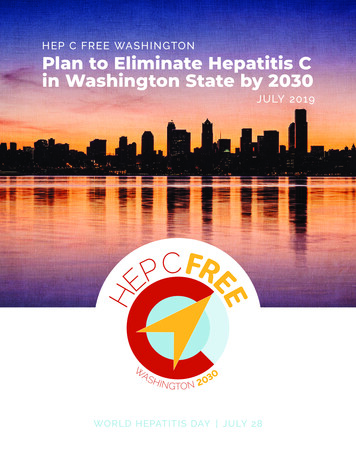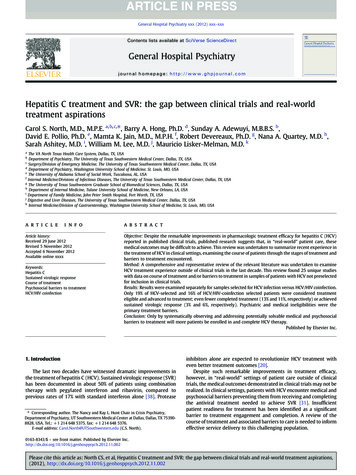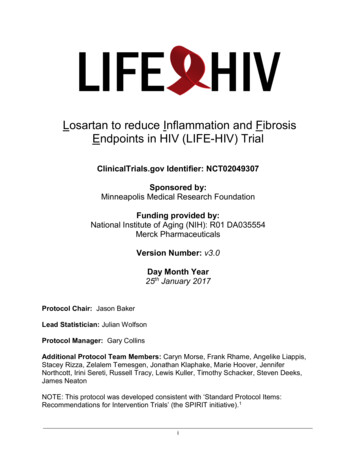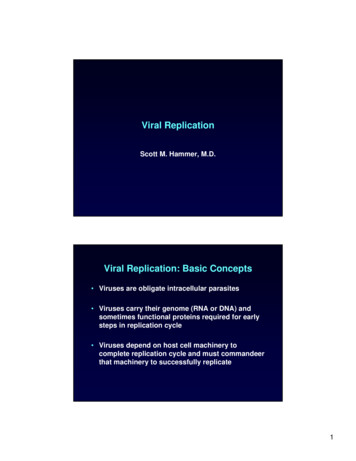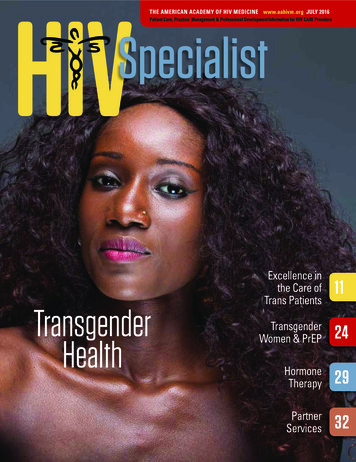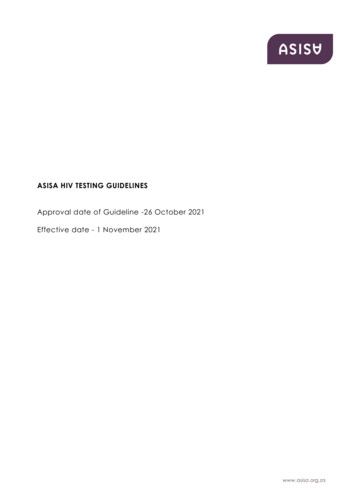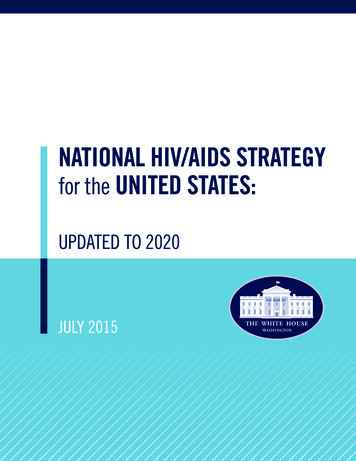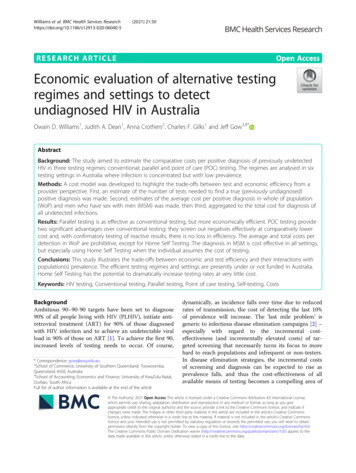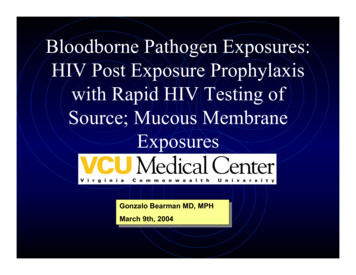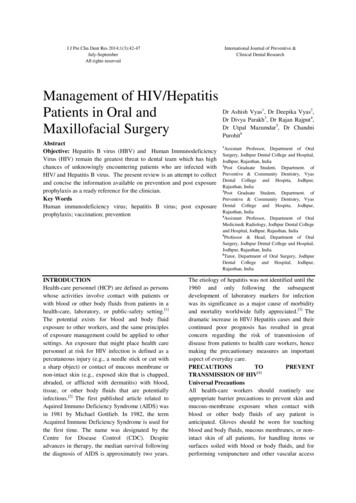
Transcription
I J Pre Clin Dent Res 2014;1(3):42-47July-SeptemberAll rights reservedInternational Journal of Preventive &Clinical Dental ResearchManagement of HIV/HepatitisDr Ashish Vyas , Dr Deepika Vyas ,Patients in Oral andDr Divya Parakh , Dr Rajan Rajput ,Dr Utpal Mazumdar , Dr ChandniMaxillofacial SurgeryPurohit123456AbstractObjective: Hepatitis B virus (HBV) and Human ImmunodeficiencyVirus (HIV) remain the greatest threat to dental team which has highchances of unknowingly encountering patients who are infected withHIV/ and Hepatitis B virus. The present review is an attempt to collectand concise the information available on prevention and post exposureprophylaxis as a ready reference for the clinician.Key WordsHuman immunodeficiency virus; hepatitis B virus; post exposureprophylaxis; vaccination; preventionINTRODUCTIONHealth-care personnel (HCP) are defined as personswhose activities involve contact with patients orwith blood or other body fluids from patients in ahealth-care, laboratory, or public-safety setting.[1]The potential exists for blood and body fluidexposure to other workers, and the same principlesof exposure management could be applied to othersettings. An exposure that might place health carepersonnel at risk for HIV infection is defined as apercutaneous injury (e.g., a needle stick or cut witha sharp object) or contact of mucous membrane ornon-intact skin (e.g., exposed skin that is chapped,abraded, or afflicted with dermatitis) with blood,tissue, or other body fluids that are potentiallyinfectious.[2] The first published article related toAquired Immuno Deficiency Syndrome (AIDS) wasin 1981 by Michael Gottlieb. In 1982, the termAcquired Immune Deficiency Syndrome is used forthe first time. The name was designated by theCentre for Disease Control (CDC). Despiteadvances in therapy, the median survival followingthe diagnosis of AIDS is approximately two years.1Assistant Professor, Department of OralSurgery, Jodhpur Dental College and Hospital,Jodhpur, Rajasthan, India2Post Graduate Student, Department. ofPreventive & Community Dentistry, VyasDental College and Hospita, Jodhpur,Rajasthan, India3Post Graduate Student, Department. ofPreventive & Community Dentistry, VyasDental College and Hospita, Jodhpur,Rajasthan, India4Assistant Professor, Department of OralMedicine& Radiology, Jodhpur Dental Collegeand Hospital, Jodhpur, Rajasthan, India5Professor & Head, Department of OralSurgery, Jodhpur Dental College and Hospital,Jodhpur, Rajasthan, India6Tutor, Department of Oral Surgery, JodhpurDental College and Hospital, Jodhpur,Rajasthan, IndiaThe etiology of hepatitis was not identified until the1960 and only following the subsequentdevelopment of laboratory markers for infectionwas its significance as a major cause of morbidityand mortality worldwide fully appreciated. [3] Thedramatic increase in HIV/ Hepatitis cases and theircontinued poor prognosis has resulted in greatconcern regarding the risk of transmission ofdisease from patients to health care workers, hencemaking the precautionary measures an importantaspect of everyday care.PRECAUTIONSTOPREVENTTRANSMISSION OF HIV[4]Universal PrecautionsAll health-care workers should routinely useappropriate barrier precautions to prevent skin andmucous-membrane exposure when contact withblood or other body fluids of any patient isanticipated. Gloves should be worn for touchingblood and body fluids, mucous membranes, or nonintact skin of all patients, for handling items orsurfaces soiled with blood or body fluids, and forperforming venipuncture and other vascular access
43Management of HIV/Hepatitis patientsVyas A, Vyas D, Parakh D, Rajput R, Mazumdar U, Purohit CTable 1: Table1: Disinfectants and their Uses, Advantages and es(CIDEX )Alcohols(iso propyl alcohol)Iodophors(betadiene vantagesVerylimiteduseaschemisterilantActive in presence ofGaseousformusedtoorganic materialsdecontaminate laboratory safetycabinetsNoncorrosive to metalActive in presence of2% formulationshigh levelorganic materialdisinfection for heat sensitiveSterilization may beequipmentaccomplished in 6-10hoursIntermediate level disinfectantDisinfect thermometers, externalsurfaces of some equipment (e.g., Fast actingstethoscopes).No residueEquipment used for home health Non stainingcareUsed as a skin antisepticLow level disinfectant for hardsurfaces and equipment that doesnot touch mucous membranes(e.g., IV poles, wheelchairs, beds,call bells)Low level gesCarcinogenicToxicStrong irritantExtremely irritating and toxic to skinand mucous membranesShelf life shortens when diluted(effective for 14-30 days dependingon formulation)High costVolatileMay harden rubberdeterioration of gluesIntoxicatingorcauseCorrosive to metal unless combinedwith inhibitorsInactivated by organic materialsRapid actionMay stain fabrics and syntheticRelatively free ofmaterialstoxicity and irritancyNote: Antiseptic iodophors are NOTsuitable for use as hard surfacedisinfectantGenerallynonDO NOT use to disinfect instrumentsand irritating to handsLimited use as disinfectant becauseUsually have detergentof narrow microbiocidal spectrumpropertiesHigh level disinfectant oscopesHigher concentrations used aschemisterilantsStabilized hydrogen peroxide(0.5%) is used a high levelsurface disinfectantprocedures. Gloves should be changed after contactwith each patient. Masks and protective eyewear orface shields should be worn during procedures thatare likely to generate droplets of blood or otherbody fluids to prevent exposure of mucousmembranes of the mouth, nose, and eyes. Gowns oraprons should be worn during procedures that arelikely to generate splashes of blood or other bodyfluids. Hands and other skin surfaces should bewashedimmediatelyandthoroughlyifcontaminated with blood or other body fluids.Hands should be washed immediately after glovesare removed. All health-care workers should takeprecautions to prevent injuries caused by needles,Strong oxidantCan be corrosive to aluminum,Fast actingcopper, brass or zincBreaks down into Surface active with limited ability towater and oxygenpenetratescalpels, and other sharp instruments or devicesduring procedures; when cleaning used instruments;during disposal of used needles; and when handlingsharp instruments after procedures. To preventneedle stick injuries, needles should not berecapped, and must be purposely bent or broken byhand, or removed from disposable syringes, orotherwise manipulated by hand. After they are used,disposable syringes and needles, scalpel blades, andother sharp items should be placed in punctureresistant containers for disposal. Although salivahas not been implicated in HIV transmission, tominimize the need for emergency mouth-to-mouthresuscitation, mouth- pieces, resuscitation bags, or
44Management of HIV/Hepatitis patientsVyas A, Vyas D, Parakh D, Rajput R, Mazumdar U, Purohit CTable 2: Disinfectants Product and recommended useS. No.123Intended useCleanup blood spills*Surface Disinfection**Instruments/surfaces contaminated with infective tissue***Disinfectant0.5% Sodium hypochlorite0.1% Sodium hypochlorite2.5 to 5% Sodium hypochlorite* Contact time at least 10 minutes.** Contact time at least 5 minutes. Wet surface with bleach solution and allow drying.***Contact time 1 hour, then rinse. Instruments require sterilization following disinfection.Table 3: Recommendation for postexposure prophylaxis for percutaneous or permucosal exposure to Hepatitis B(HB) virusTreatment whenVaccination and antibodyTreatment when source is notHBsAg seropositivesource is HBsAgstatus of exposed persontested or status is unknownnegativeHepatitis B ImmunoglobulinInitiate HB vaccineUnvaccinated(HBIG*) 1 and initiate HBInitiate HBseriesvaccine seriesNo treatmentPreviously vaccinatedNo treatmentNo treatmentIf known high-risk source, treatKnown responder†HBIG* 2 or HBIG* 1 andNo treatmentas if source were HBsAgKnown non responderinitiate revaccinationpositiveTest exposed person for antiTest exposed person for antiHBs:HBs:Antibody response unknown If adequate,† no treatment;No treatmentIf adequate,† no treatment;If inadequate,† HBIG 1 andIfinadequate,†initiatevaccine boosterrevaccination*Dose 0.06 mg/kg IM.†Responder is defined as a person with adequate serum levels of anti-HBs ( 10 mIU/ml); inadequate vaccination defined as serum anti-HBs 10 mIU/mlother ventilation devices should be available for usein areas in which the need for resuscitation ispredictable. Health-care workers who haveexudative lesions or weeping dermatitis shouldrefrain from all direct patient care and fromhandling patient-care equipment until the conditionresolves.Precautions for Dentistry[4]In addition to wearing gloves for contact with oralmucous membranes of all patients, all dentalworkers should wear surgical masks and protectiveeyewear or chin-length plastic face shields duringdental procedures in which splashing or spatteringof blood, saliva, or gingival fluids is likely. Rubberdams, high-speed evacuation and proper patientpositioning, when appropriate, should be utilized tominimize generation of droplets and spatter.Handpieces should be sterilized after use with eachpatient, since blood, saliva, or gingival fluid ofpatients may be aspirated into the handpiece orwaterline. Handpieces that cannot be sterilizedshould at least be flushed, the outside surfacecleaned and wiped with a suitable chemicalgermicide, and then rinsed. Handpieces should beflushed at the beginning of the day and after usewith each patient. The same precautions should beused for ultrasonic scalers and air/water syringes.Blood and saliva should be thoroughly and carefullycleaned from material that has been used in themouth (e.g., impression materials, bite registration),especially before polishing and grinding intra-oraldevices. Contaminated materials, impressions, andintra-oral devices should also be cleaned anddisinfected before being handled in the dentallaboratory and before they are placed in the patient'smouth. Because of the increasing variety of dentalmaterials used intra-orally, dental workers shouldconsult with manufacturers as to the stability ofspecific materials when using disinfectionprocedures. Dental equipment and surfaces that aredifficult to disinfect (e.g., light handles or X-rayunit heads) and that may become contaminatedshould be wrapped with impervious-backed paper,aluminum foil, or clear plastic wrap. The coveringsshould be removed and discarded, and cleancoverings should be put in place after use with eachpatient.STERLIZATIONAll form of sterilization will destroy HIV/ HBV.Methods of sterilization recommended by worldHealth Organisation (WHO) (2000a) are; a) steam(or moist heat) under pressure (eg. autoclave orpressure cooker); b) dry heat (such as an oven) or;
45Management of HIV/Hepatitis patientsVyas A, Vyas D, Parakh D, Rajput R, Mazumdar U, Purohit CTable 4: Basic and Expanded HIV Post-exposure Prophylaxis RegimensBASIC REGIMENZidovudine (Retrovir ; ZDV; AZT) lamivudine (Epivir ; 3TC); available as Combivir Preferred dosing - ZDV: 300 mg twice daily or 200 mg three times daily, with food; total: 600 mg daily- 3TC: 300 mg once daily or 150 mg twice daily- Combivir: one tablet twice dailyAdvantages ZDV associated with decreased risk for HIV transmission- ZDV used more often than other drugs for PEP for health-care personnel (HCP)- Can be used by pregnant HCPDisadvantagesSource-patient virus resistance to this regimen possibleALTERNATE BASIC REGIMENSLamivudine (Epivir ; 3TC) stavudine (Zerit ; d4T)Preferred dosing- 3TC: 300 mg once daily or 150 mg twice daily- d4T: 40 mg twice daily; 30 mg twice daily if body weight is 60 kgc) gas sterilization (with ethylene oxide) for nonheat resistant equipment.[4]1. Moist heat (autoclaving) readily kills HIV/ HBVat 1210 C for 15 minutes or 1260 C for 10minutes or 1340 C for 3-5 minutes2. Dry heat at 1210 C for 16 hours, 1400 C for 3hours, 1600 C for 2 hours or 1700 C for 1 hour issufficient to kill HIV/ HBV3. Exposure to ethylene oxide for between 4 and 16hours, depending on the object and its volume,will be sufficient. The object must then be leftfor several days to allow the gas to evaporate.[4]The various disinfectants and their uses, advantagesand disadvantages are as described in the Table 1,[5]disinfectants product and recommended use areshown in Table 2.Hepatitis B vaccinationAdminister missing doses to complete a 3-doseseries of hepatitis B vaccine to those persons notvaccinated or not completely vaccinated. Thesecond dose should be administered 1 month afterthe first dose; the third dose should be given at least2 months after the second dose (and atleast 4monthsafter the first dose). If the combined hepatitis A andhepatitis B vaccine (Twinrix) is used, give 3 dosesat 0, 1, and 6 months; alternatively, a 4-doseTwinrix schedule, administered on days 0, 7, and21-30 followed by a booster dose at month 12 maybe used.[6] Recommendation for postexposureprophylaxis for percutaneous or permucosalexposure to hepatitis B virus shown on Table 3.[7]Situations for which expert consultations forHIV post exposure prophylaxis (PEP) isadvised[8] Delayed (i.e., later than 24-36 hours) exposurereport- Interval after which lack of benefit from PEPundefined Unknown source (e.g., needle in sharps disposalcontainer or laundry)- Use of PEP to be decided on a case by casebasis- Considerseverityofexposureandepidemiologic likelihood of HIV exposure- Do not test needles or other sharp instrumentsfor HIV- Known or suspected pregnancy in exposedperson- Use of optimal PEP regimens not precluded- PEP not denied solely on basis of pregnancy Breastfeeding in the exposed person- Use of optimal PEP regimens not precluded- PEP not denied solely on basis ofbreastfeeding Resistance of the source virus to antiretroviralagents- Influence of drug resistance on transmissionrisk unknown- If source persons virus is known or suspectedto be resistant to one or more of the drugconsidered for PEP, selection of drugs towhich the source person virus is unlikely to beresistant recommended- Resistance testing of the source persons virusat the time of exposure not recommended- Initiation of PEP not to be delayed whileawaiting any results of resistance testing Toxicity of the initial PEP regimen
46Management of HIV/Hepatitis patientsVyas A, Vyas D, Parakh D, Rajput R, Mazumdar U, Purohit CTable 5: Recommended HIV postexposure prophylaxis for mucous membrane exposure and nonintact skin exposureInfection status of sourceExposureHIV positiveHIV positiveSource of unknown HIVHIVUnknown sourcetypeclass 1class 2statusnegativeGenerally no PEPGenerally no PEP warrantedRecommendwarranted; howeverhowever consider basic 2 drugSmallConsider basicNo PEPbasic 2-drungconsider basic drug PEPPEP in settings where exposurevolume2-drug PEPwarrantedPEPfor source with HIV riskto HIV infected persons isfactorslikelyGenerally no PEPGenerally no PEP warrantedRecommendRecommendwarranted howeverhowever consider basic 2 drugLargeNo PEPbasic 2 drugexpanded 3 drug consider basic 2 drug PEP PEP in settings where exposurevolumewarrantedPEPPEPfor source with hiv riskto HIV infected persons isfactorslikely- Adverse symptoms common with PEP- Symptoms often manageable without changingPEP regimen by prescribing antimotility orantiemetic agents- In other situations, modifying the dose intervalmight help alleviate symptoms when theyoccur.Timing and duration of PEP are important, but theoptimal duration is unknown.[9-12] PEP should beinitiated as soon as possible after an exposure.[9,13]PEP is most effective when initiated before 24 to 36hours after exposure;[13,14] regimens started morethan 72 hours after exposure and continued for lessthan four weeks are believed to be less effective.Although appropriate PEP is almost alwayseffective in preventing HIV infection, failures havebeen documented.[9,13] Basic and expanded HIVpostexposure prophylaxis regimens is discussed onTable 4.[8] Recommended HIV postexposureprophylaxis for mucous membrane exposure andnonintact skin exposure is shown on Table 5.[14]SUMMARYAvoiding occupational blood exposure is theprimary way to prevent transmission of HBV andHIV in health care settings. An appropriate postexposure management is an important element ofwork place safety. Maintenance of immunity is anintegral part of prevention of disease for health careworkers because of their contact with patients orinfectivematerialfrompatients.Properimmunization schedule could substantially reduceboth the number of susceptible health care workersand the attendant risks for transmission of vaccinepreventable diseases to other workers and patients.REFERENCES:1. Centers for Disease Control and Prevention.[Updated U.S. Public Health ServiceGuidelinesfortheManagementofOccupational Exposures to HBV, HCV, andHIV and Recommendations for PostexposureProphylaxis]. MMWR 2000;50:112. Updated US Public Health Service Guidelinesfor the Management of OccupationalExposures to HIV and Recommendations forPostexposure Prophylaxis. MMWR 2005;54:117.3. Blumberg BS, Alter HJ, Visnich S. A newAntigeninleukemiasera.JAMA1965;191:541-6.4. Recommendations for Prevention of HIVTransmission in Health-Care Settings.1987;36(2);1.5. Infection Control Guidelines. Hand washing,Cleaning, Disinfection and Sterilization inHealth Recommended Adult 7.6. Elizabeth A. Guideline for infection control inhealth care personnel. American Journal ofInfection Control 1998;26:289-354.7. Basic and Expanded HIV -52.8. Panlilio AL. Updated US Public HealthService guidelines for the management ofoccupational exposures to HIV andrecommendationsforpostexposureprophylaxis. MMWR 2005;54(9):1-17.9. Ende AR. Nonoccupational postexposureprophylaxis for exposure to HIV in New YorkState emergency departments. AIDS PatientCare STDS 2008;22(10):797-802.10. Bryant J, Baxter L, Hird S. Non-occupationalpostexposure prophylaxis for HIV: asystematicreview.HealthTechnolAssess. 2009;13(14):1-60.11. Young TN. Antiretroviral post-exposureprophylaxis (PEP) for occupational HIV
47Management of HIV/Hepatitis patientsexposure. Cochrane Database Syst Rev2007;(1):CD002835.12. Smith DK. Antiretroviral postexposureprophylaxis after sexual, injection-drug use, orother nonoccupational exposure to HIV in theUnited States: recommendations from the USDepartment of Health and Human Services.MMWR Recomm Rep 2005;54(2):1-20.13. Havens PL. American Academy of PediatricsCommittee on Pediatric AIDS. Postexposureprophylaxis in children and adolescents irus.Pediatrics2003;111(6):1475-89.14. Updated US Public Health Service Guidelinesfor the Management of OccupationalExposures to HBV, HCV, and HIV andRecommendationsforPostexposureProphylaxis. MMWR 2001;50(11):1-42.Vyas A, Vyas D, Parakh D, Rajput R, Mazumdar U, Purohit C
Patients in Oral and Maxillofacial Surgery Abstract Objective: Hepatitis B virus (HBV) and Human Immunodeficiency Virus (HIV) remain the greatest threat to dental team which has high chances of unknowingly encountering patients who are infected with HIV/ and Hepatitis B virus. The present review is an attempt to collect
